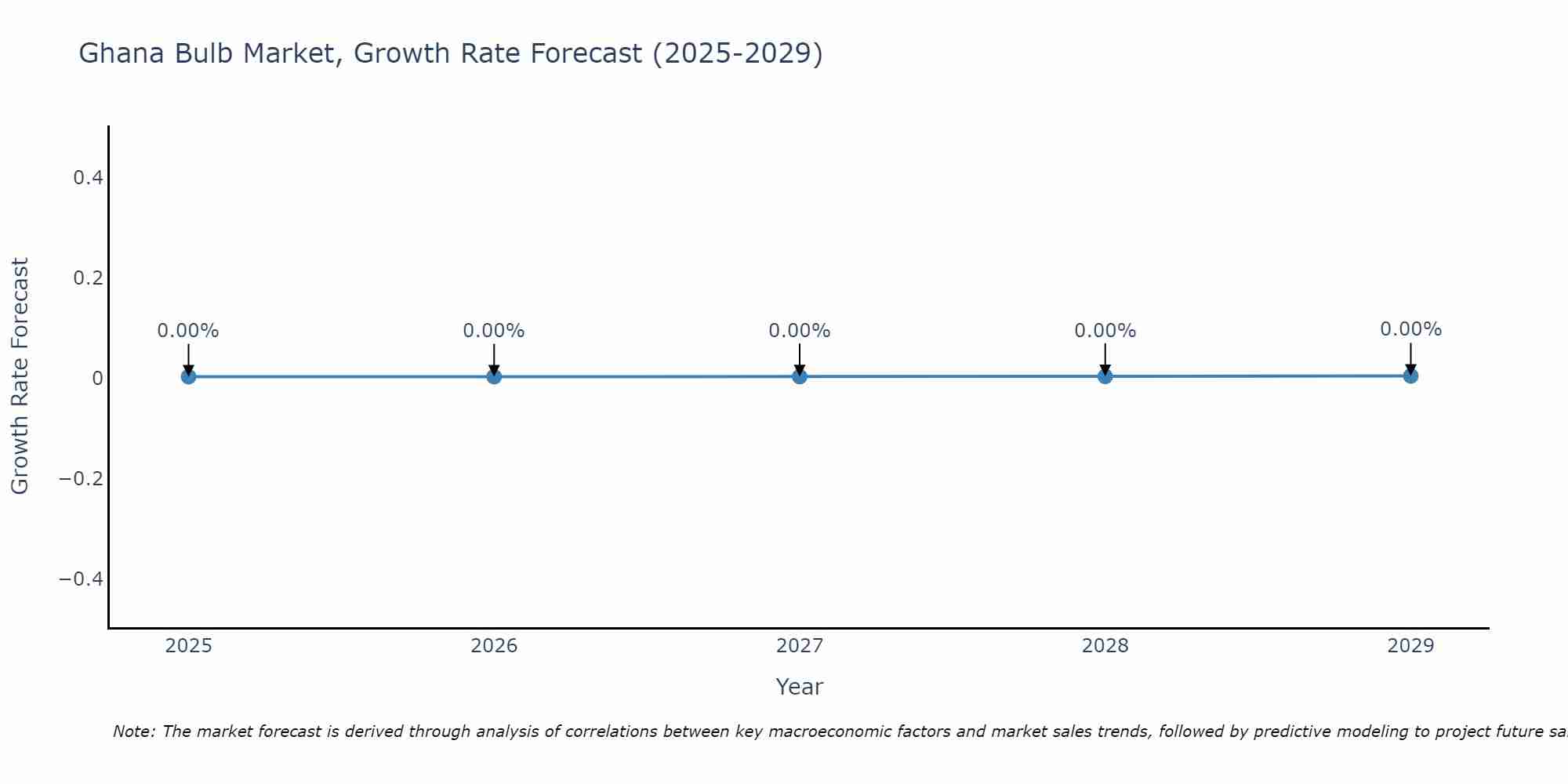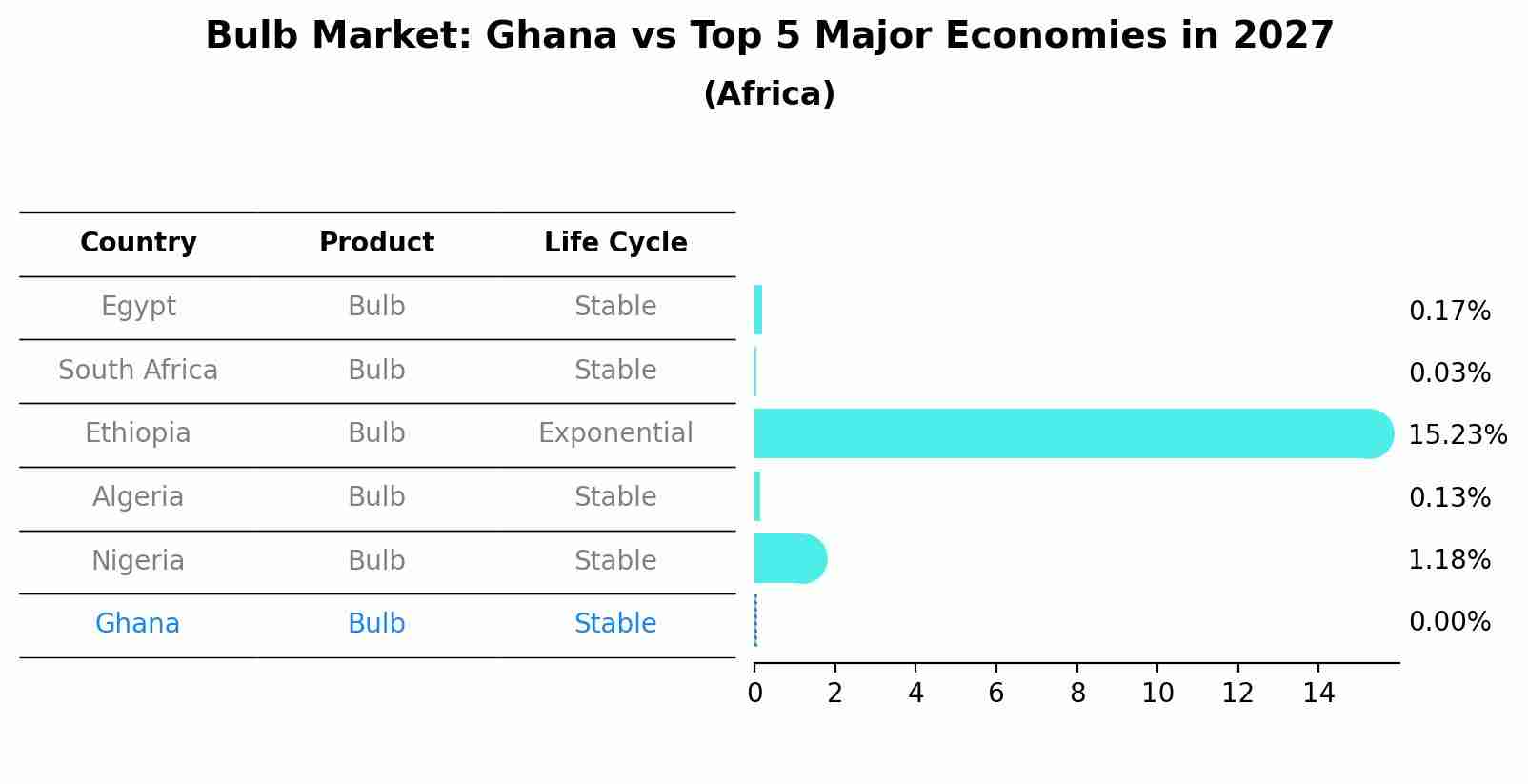Ghana Bulb Market (2025-2031) Outlook | Trends, Industry, Value, Share, Analysis, Forecast, Revenue, Size, Growth & Companies
| Product Code: ETC258776 | Publication Date: Aug 2022 | Updated Date: Aug 2025 | Product Type: Market Research Report | |
| Publisher: 6Wresearch | Author: Ravi Bhandari | No. of Pages: 75 | No. of Figures: 35 | No. of Tables: 20 |
Ghana Bulb Market Size Growth Rate
The Ghana Bulb Market is poised for steady growth rate improvements from 2025 to 2029. From 0.00% in 2025, the growth rate steadily ascends to 0.00% in 2029.

Bulb Market: Ghana vs Top 5 Major Economies in 2027 (Africa)
In the Africa region, the Bulb market in Ghana is projected to expand at a stable growth rate of 0.00% by 2027. The largest economy is Egypt, followed by South Africa, Ethiopia, Algeria and Nigeria.

Ghana Bulb Market Overview
The Ghana Bulb Market is witnessing growth propelled by factors such as urbanization, electrification initiatives, and demand for energy-efficient lighting solutions. Bulbs, including incandescent, fluorescent, and LED bulbs, serve as primary light sources for residential, commercial, and industrial applications, contributing to their demand in Ghana lighting market.
Drivers of the market
The bulb market in Ghana is driven by the demand for energy-efficient lighting solutions and the phase-out of incandescent bulbs in favor of compact fluorescent lamps (CFLs) and light-emitting diode (LED) bulbs. Energy-efficient bulbs offer advantages such as longer lifespan, lower energy consumption, and reduced maintenance costs, supporting their adoption in residential, commercial, and industrial lighting applications.
Challenges of the market
In Ghana, the bulb market encounters challenges such as technological transition, energy efficiency, and market competition. Bulbs, including incandescent, fluorescent, and LED (light-emitting diode) bulbs, are essential lighting products used in residential, commercial, and industrial applications. However, the transition from traditional incandescent and fluorescent bulbs to energy-efficient LED bulbs may pose challenges for manufacturers, distributors, and consumers. Moreover, ensuring the affordability and accessibility of LED bulbs, particularly for low-income households and rural communities, may require government subsidies and market incentives. Additionally, addressing concerns about bulb quality, performance, and reliability, especially with counterfeit and substandard products, is crucial to build consumer trust and confidence. Overcoming these challenges through technology innovation, market education, and policy support is essential to accelerate the adoption of energy-efficient lighting solutions in Ghana and promote sustainable development.
Government Policy of the market
Government interventions in the bulb market may aim to promote energy efficiency, environmental sustainability, and consumer safety in lighting products. Policies might include energy efficiency standards and labeling requirements for bulbs to encourage the adoption of energy-saving technologies such as LED and CFL bulbs. Additionally, the government may offer financial incentives or rebates for the purchase of energy-efficient bulbs to accelerate market adoption and reduce electricity consumption. Public awareness campaigns on the benefits of energy-efficient lighting and proper bulb disposal practices may also be supported to encourage sustainable consumer behavior.
Key Highlights of the Report:
- Ghana Bulb Market Outlook
- Market Size of Ghana Bulb Market, 2024
- Forecast of Ghana Bulb Market, 2031
- Historical Data and Forecast of Ghana Bulb Revenues & Volume for the Period 2021-2031
- Ghana Bulb Market Trend Evolution
- Ghana Bulb Market Drivers and Challenges
- Ghana Bulb Price Trends
- Ghana Bulb Porter's Five Forces
- Ghana Bulb Industry Life Cycle
- Historical Data and Forecast of Ghana Bulb Market Revenues & Volume By Type for the Period 2021-2031
- Historical Data and Forecast of Ghana Bulb Market Revenues & Volume By Incandescent Bulbs for the Period 2021-2031
- Historical Data and Forecast of Ghana Bulb Market Revenues & Volume By Fluorescent Bulbs for the Period 2021-2031
- Historical Data and Forecast of Ghana Bulb Market Revenues & Volume By CFLs for the Period 2021-2031
- Historical Data and Forecast of Ghana Bulb Market Revenues & Volume By Halogens for the Period 2021-2031
- Historical Data and Forecast of Ghana Bulb Market Revenues & Volume By LEDs for the Period 2021-2031
- Historical Data and Forecast of Ghana Bulb Market Revenues & Volume By Application for the Period 2021-2031
- Historical Data and Forecast of Ghana Bulb Market Revenues & Volume By Lamps & Light Bulbs for the Period 2021-2031
- Historical Data and Forecast of Ghana Bulb Market Revenues & Volume By Operation Theatre (OT Instruments) for the Period 2021-2031
- Historical Data and Forecast of Ghana Bulb Market Revenues & Volume By Torchlights and Flashlights for the Period 2021-2031
- Historical Data and Forecast of Ghana Bulb Market Revenues & Volume By Automobile Headlights for the Period 2021-2031
- Historical Data and Forecast of Ghana Bulb Market Revenues & Volume By Mining Headgears for the Period 2021-2031
- Historical Data and Forecast of Ghana Bulb Market Revenues & Volume By Others for the Period 2021-2031
- Ghana Bulb Import Export Trade Statistics
- Market Opportunity Assessment By Type
- Market Opportunity Assessment By Application
- Ghana Bulb Top Companies Market Share
- Ghana Bulb Competitive Benchmarking By Technical and Operational Parameters
- Ghana Bulb Company Profiles
- Ghana Bulb Key Strategic Recommendations
Frequently Asked Questions About the Market Study (FAQs):
1 Executive Summary |
2 Introduction |
2.1 Key Highlights of the Report |
2.2 Report Description |
2.3 Market Scope & Segmentation |
2.4 Research Methodology |
2.5 Assumptions |
3 Ghana Bulb Market Overview |
3.1 Ghana Country Macro Economic Indicators |
3.2 Ghana Bulb Market Revenues & Volume, 2021 & 2031F |
3.3 Ghana Bulb Market - Industry Life Cycle |
3.4 Ghana Bulb Market - Porter's Five Forces |
3.5 Ghana Bulb Market Revenues & Volume Share, By Type, 2021 & 2031F |
3.6 Ghana Bulb Market Revenues & Volume Share, By Application, 2021 & 2031F |
4 Ghana Bulb Market Dynamics |
4.1 Impact Analysis |
4.2 Market Drivers |
4.2.1 Increasing demand for energy-efficient lighting solutions |
4.2.2 Government initiatives promoting the use of sustainable lighting technologies |
4.2.3 Growth in urbanization and infrastructure development leading to higher demand for bulbs |
4.3 Market Restraints |
4.3.1 Fluctuating prices of raw materials impacting production costs |
4.3.2 Competition from alternative lighting technologies such as LED bulbs |
5 Ghana Bulb Market Trends |
6 Ghana Bulb Market, By Types |
6.1 Ghana Bulb Market, By Type |
6.1.1 Overview and Analysis |
6.1.2 Ghana Bulb Market Revenues & Volume, By Type, 2021-2031F |
6.1.3 Ghana Bulb Market Revenues & Volume, By Incandescent Bulbs, 2021-2031F |
6.1.4 Ghana Bulb Market Revenues & Volume, By Fluorescent Bulbs, 2021-2031F |
6.1.5 Ghana Bulb Market Revenues & Volume, By CFLs, 2021-2031F |
6.1.6 Ghana Bulb Market Revenues & Volume, By Halogens, 2021-2031F |
6.1.7 Ghana Bulb Market Revenues & Volume, By LEDs, 2021-2031F |
6.2 Ghana Bulb Market, By Application |
6.2.1 Overview and Analysis |
6.2.2 Ghana Bulb Market Revenues & Volume, By Lamps & Light Bulbs, 2021-2031F |
6.2.3 Ghana Bulb Market Revenues & Volume, By Operation Theatre (OT Instruments), 2021-2031F |
6.2.4 Ghana Bulb Market Revenues & Volume, By Torchlights and Flashlights, 2021-2031F |
6.2.5 Ghana Bulb Market Revenues & Volume, By Automobile Headlights, 2021-2031F |
6.2.6 Ghana Bulb Market Revenues & Volume, By Mining Headgears, 2021-2031F |
6.2.7 Ghana Bulb Market Revenues & Volume, By Others, 2021-2031F |
7 Ghana Bulb Market Import-Export Trade Statistics |
7.1 Ghana Bulb Market Export to Major Countries |
7.2 Ghana Bulb Market Imports from Major Countries |
8 Ghana Bulb Market Key Performance Indicators |
8.1 Percentage of households using energy-efficient bulbs |
8.2 Number of government projects incorporating sustainable lighting solutions |
8.3 Urbanization rate in Ghana |
8.4 Price index of raw materials used in bulb manufacturing |
8.5 Market share of LED bulbs in the lighting industry in Ghana |
9 Ghana Bulb Market - Opportunity Assessment |
9.1 Ghana Bulb Market Opportunity Assessment, By Type, 2021 & 2031F |
9.2 Ghana Bulb Market Opportunity Assessment, By Application, 2021 & 2031F |
10 Ghana Bulb Market - Competitive Landscape |
10.1 Ghana Bulb Market Revenue Share, By Companies, 2024 |
10.2 Ghana Bulb Market Competitive Benchmarking, By Operating and Technical Parameters |
11 Company Profiles |
12 Recommendations |
13 Disclaimer |
- Single User License$ 1,995
- Department License$ 2,400
- Site License$ 3,120
- Global License$ 3,795
Search
Related Reports
- Portugal Electronic Document Management Market (2025-2031) | Strategy, Consumer Insights, Analysis, Investment Trends, Opportunities, Growth, Size, Share, Industry, Revenue, Segments, Value, Segmentation, Supply, Forecast, Restraints, Outlook, Competition, Drivers, Trends, Demand, Pricing Analysis, Competitive, Strategic Insights, Companies, Challenges
- France Electronic Document Management Market (2025-2031) | Strategy, Consumer Insights, Analysis, Investment Trends, Opportunities, Growth, Size, Share, Industry, Revenue, Segments, Value, Segmentation, Supply, Forecast, Restraints, Outlook, Competition, Drivers, Trends, Demand, Pricing Analysis, Competitive, Strategic Insights, Companies, Challenges
- Portugal Occupational Health & Safety Services Market (2025-2031) | Strategy, Consumer Insights, Analysis, Investment Trends, Opportunities, Growth, Size, Share, Industry, Revenue, Segments, Value, Segmentation, Supply, Forecast, Restraints, Outlook, Competition, Drivers, Trends, Demand, Pricing Analysis, Competitive, Strategic Insights, Companies, Challenges
- Netherlands Occupational Health and Safety Services Market (2025-2031) | Strategy, Consumer Insights, Analysis, Investment Trends, Opportunities, Growth, Size, Share, Industry, Revenue, Segments, Value, Segmentation, Supply, Forecast, Restraints, Outlook, Competition, Drivers, Trends, Demand, Pricing Analysis, Competitive, Strategic Insights, Companies, Challenges
- Belgium and Luxembourg Facility Management Market (2025-2031) | Strategy, Consumer Insights, Analysis, Investment Trends, Opportunities, Growth, Size, Share, Industry, Revenue, Segments, Value, Segmentation, Supply, Forecast, Restraints, Outlook, Competition, Drivers, Trends, Demand, Pricing Analysis, Competitive, Strategic Insights, Companies, Challenges
- Russia Women Intimate Apparel Market (2025-2031) | Strategy, Consumer Insights, Analysis, Investment Trends, Opportunities, Growth, Size, Share, Industry, Revenue, Segments, Value, Segmentation, Supply, Forecast, Restraints, Outlook, Competition, Drivers, Trends, Demand, Pricing Analysis, Competitive, Strategic Insights, Companies, Challenges
- Africa Chocolate Market (2025-2031) | Size, Share, Trends, Growth, Revenue, Analysis, Forecast, industry & Outlook
- Global Hydroxychloroquine And Chloroquine Market (2025-2031) | Industry, Trends, Size, Outlook, Growth, Value, Companies, Revenue, Analysis, Share, Forecast
- Saudi Arabia Plant Maintenance Market (2025-2031) | Industry, Size, Growth, Revenue, Value, Companies, Forecast, Analysis, Share & Trends
- Taiwan Electric Truck Market (2025-2031) | Outlook, Industry, Revenue, Size, Forecast, Growth, Analysis, Share, Companies, Value & Trends
Industry Events and Analyst Meet
Our Clients
Whitepaper
- Middle East & Africa Commercial Security Market Click here to view more.
- Middle East & Africa Fire Safety Systems & Equipment Market Click here to view more.
- GCC Drone Market Click here to view more.
- Middle East Lighting Fixture Market Click here to view more.
- GCC Physical & Perimeter Security Market Click here to view more.
6WResearch In News
- Doha a strategic location for EV manufacturing hub: IPA Qatar
- Demand for luxury TVs surging in the GCC, says Samsung
- Empowering Growth: The Thriving Journey of Bangladesh’s Cable Industry
- Demand for luxury TVs surging in the GCC, says Samsung
- Video call with a traditional healer? Once unthinkable, it’s now common in South Africa
- Intelligent Buildings To Smooth GCC’s Path To Net Zero













